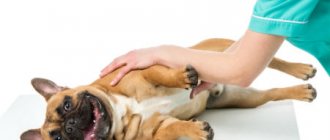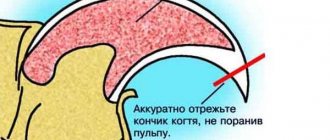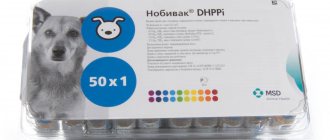Indications for the procedure
Animals are curious, and they not only smell some objects, but also try to taste them.
While walking, a dog may inhale toxic fumes, eat spoiled food, or accidentally swallow foreign objects.
Problems with the gastrointestinal tract also arise when fur gets into the pet’s stomach after licking. These situations cause discomfort in the animal and require urgent action.
Symptoms of poisoning
Signs of indigestion may vary depending on the cause that caused it.
There are also general symptoms that appear in all cases:
- rapid breathing;
weakness;- shiver;
- excessive salivation;
- vomit;
- diarrhea;
- refusal of food;
The pet's behavior changes - it becomes depressed or agitated.
In severe poisoning, convulsive muscle twitching and loss of consciousness are observed.
Prices at the veterinary clinic
If possible, it is necessary to take your pet to a veterinary hospital. The clinic will do everything quickly and professionally.
But this service is paid and costs about 2000 rubles.
Having found out how much the procedure costs, not everyone will be able to pay for it right away, and sometimes the veterinary hospital is far away, and there is no time to waste. Therefore, you should know how to provide help at home.
Indications for gastric lavage
The dissolution of poisons in the stomach and their absorption occurs within an hour. It would seem that it was during this period that one could understand that something had happened to the dog. And if you also know what poisoned the animal, then, as a rule, there are no problems with providing first aid. However, poisoning can be not only acute, when all the symptoms are visible, but also sluggish.
Gastric lavage is more often required for puppies who want to try everything by tooth.
In case of poisoning, the following symptoms may occur:
- Lethargy and weakness.
- Paleness of the mucous membranes.
- Increased salivation.
- Refusal to eat, and sometimes even water.
- Diarrhea and vomiting.
- Strange smell and color of stool.
- Pain in the peritoneal area.
- Unpleasant odor from the mouth.
- Cramps.
- Decreased body temperature.
- Loss of consciousness.
Important. Similar symptoms can be caused by many bacterial and viral diseases. Therefore, it is important not to waste time and show the dog to the veterinarian.
If you know for sure that your dog has swallowed something poisonous, you need to immediately rinse his stomach. If you manage to do this in the first 20 minutes, then severe poisoning can be avoided. Although rinsing is also used at a later stage, the main thing is to act together with the veterinarian and listen to his advice.
Algorithm of actions at home
The first thing an owner can do is to make the dog vomit violently. To do this, you can sprinkle a little salt on your pet's tongue (at the base). But a more effective result is obtained by washing with copious amounts of liquid.
If the animal itself is not able to drink, it will have to be helped in this by acting as follows:
- take at least 1 liter of warm, clean water;
- fill a rubber bulb with a capacity of 100-200 ml with liquid;
- insert the end of the device between the teeth on the side of the mouth;
- pour water over the dog's cheek.
The procedure is repeated until the prepared liquid runs out. If you have pharmaceutical or improvised means on hand, you can add them to the water in the required proportions.
After gastric lavage, the pet is given sorbents (Enterosgel, Polysorb or activated carbon).
After half an hour, you need to do an enema with salted water (1 tsp per glass of liquid) or introduce a laxative (vaseline, castor oil).
Features of treatment of puppies and small breed dogs
The solution for gastric lavage of small animals is taken in smaller volumes:
- for small breeds – 0.5 l;
- puppy – 1 glass.
Instead of a syringe, use a large syringe without a needle. To make it more convenient to administer the liquid, it is advisable to have an assistant who will limit the pet’s resistance.
Sorbents are used according to instructions. Dosage is the same as for children under 2 years of age.
The process of gastric lavage for a dog
As you might have guessed, this process can bring a lot of discomfort to the pet, so it is better to do the washing together with someone so that you can restrain the dog when necessary. Here is a list of things that may be useful to you in the process:
- Solution intended for washing. To do this, you can use pharmaceutical preparations, soda, manganese or table salt.
- Syringe.
- A large syringe, as well as a tube removed from the IV system. YOU can take any other similar device with which it will be convenient to pour liquid into the animal’s mouth.
- Absorbents. This often includes the simplest remedy - activated carbon; you can use any of its analogues.
- Laxatives.
- Substances intended to coat the walls of the stomach and intestines. Ask your doctor which ones are best to buy.
Here are the two most popular solutions with their preparation methods:
Saline solution. Take a teaspoon of ordinary table salt, then add 6-18 ml of solution depending on the animal’s body weight.
Potassium permanganate. Take a toothpick, dip it in potassium permanganate, and then into a glass of water. Start stirring until the liquid becomes smooth. Let the solution sit a little, then drain off the top layer. Only pale pink liquid should remain, and feed your pet with it.
Now try to induce vomiting, if problems arise, try to press on the walls of the stomach until the urge arises. In rare situations, if the urge was not caused in this way, wrap two fingers in a towel and then press on the root of your pet’s tongue.
Note! Under no circumstances should you hesitate if you find blood, feces or even bile in the remaining vomit. In this case, only a veterinarian can help the pet.
How to rinse a dog's stomach
Useful materials:
- How to put drops in a dog's eyes How to easily carry out an instillation session? Sit comfortably, take the dog in your arms, sit him with his back to...
- How to trim a dog’s nails Anatomy of a dog’s clawsBefore you start trimming your dog’s nails, you need to know the structure of a dog’s claw. A dog’s claw has…
- Corvalol dosage for a dog: To give or not to give Many breeders are interested in whether it is possible to give a dog Corvalol. There is an opinion that this…
- Smecta for a dog with diarrhea How does the drug work? In the intestines of any living creature there is a mucous membrane that protects tissues from injury.…
Ridding your pet of fur
Hairballs that enter the digestive system cause no less inconvenience than toxins. They provoke vomiting or persistent constipation.
To help your pet get rid of fur, you can use medications prescribed by your veterinarian.
Or use traditional methods:
- give the dog Vaseline oil (1 tbsp);
- boil and puree the pumpkin pulp (give 7 g for small animals, 14 g for large animals).
The second method to cleanse the stomach is suitable if the pet does not refuse food and a little hair has collected inside.
If a foreign object enters the stomach
Things that enter an animal's stomach or intestines can remain there for a long time without causing any symptoms. And they can cause blockage of the gastrointestinal tract.
Even if foreign bodies do not interfere at first, over time they begin to irritate the mucous membrane and cause the dog to develop gastritis or ulcers.
Flushing will help if the dog has recently swallowed the item and it is too small to pass out of the body on its own.
In other cases, the procedure can provoke a rupture of the walls. Here it is better to proceed as when cleansing the stomach of hair, using laxatives or foods high in fiber.
If your attempt to cleanse the intestines is unsuccessful, it is better to contact a veterinary clinic. Specialists will help you remove the foreign body using endoscopic equipment.
How to rinse a dog's stomach yourself?
For rinsing, it is better to make a weak solution of potassium permanganate of a pale pink color. You can also make salted or regular tea instead of potassium permanganate, dissolve dry mustard (a tablespoon per glass of water). In no case should milk be given as a neutralizing agent; with some poisons, it can, on the contrary, cause acceleration of absorption. The amount of liquid depends on the weight of the dog and can be from a glass for a Chihuahua to three liters for an Alabai.
It is recommended to pour in the gastric lavage solution from a syringe. And this must be done slowly so that the dog does not choke. Of course, you need someone to hold the dog well or come up with a reliable way to secure it. If you don’t have a syringe, you can use a syringe without a needle of maximum volume.
Therefore, if there is the slightest doubt, it is better to consult a veterinarian, at least by phone. It is also necessary to always take all precautions so that the dog, and especially the puppy, does not get poisoned: remove hazardous substances, chemicals, medications, fertilizers, cosmetics and detergents from places inaccessible to the dog.
Regardless of the age of the dog, due to their very curious nature, they are often exposed to various poisonings by eating inedible objects. Poisoning with drugs and chemicals is especially dangerous. In this case, the animal needs to be given immediate help, since in a matter of hours the poison will spread throughout the body.
The most correct and optimal solution in such a situation is gastric lavage.
How to clean it
Not only water is used for gastric lavage. There are more effective remedies that you can prepare at home.
Solutions for dogs in case of poisoning
| Means | Proportions | Note |
| Hydrogen peroxide | 1:1 | The amount of liquid is taken at the rate of 1 tbsp. per 3 kg body weight |
| Salt | 2 tsp/1 glass of water | Inject 6-20 ml (depending on the size of the dog) |
| Baking soda | 1 tsp/glass of water | |
| Mustard | 1 tbsp. powder/ glass of water | The solution is not recommended for puppies |
Hydrogen peroxide is handled with care: upon contact with saliva, it foams and causes discomfort in the pet.
The solution should be given in small portions of 5-10 ml at five-minute intervals.
Potassium permanganate
Veterinarians have an ambiguous attitude towards this pharmaceutical product. Some experts do not recommend rinsing the dog’s stomach with potassium permanganate, so as not to burn the walls of the esophagus .
Others, on the contrary, put the remedy in 1st place when providing immediate assistance. To avoid consequences, prepare the solution as follows:
- a liter jar is filled with warm water;
moisten the tip of a toothpick and dip it in manganese so that a small amount of crystals remains on it;- rinse in a jar of water;
- stir thoroughly;
- wait until undissolved crystals settle to the bottom;
- filter through 3-4 layers of gauze.
To obtain a weak solution of pale pink color, 0.5 liters of liquid is poured into a clean jar and diluted with the same amount of water. You can safely give such a drug to your pet.
Contraindications to gastric lavage
Many dog owners do not even suspect that rinsing the stomach is sometimes not advisable and even dangerous. Just like feeding your pet milk and egg white. If the dog has suffered from viruses, or the intestines have already been affected by poisons, protein and milk will accelerate the development of a negative reaction in the body, serving as a real catalyst.
If a dog is poisoned, milk is strictly contraindicated.
If you don’t understand what could have poisoned your dog, then you shouldn’t panic, but try to think through the possible reasons as carefully as possible. Remember if there were containers with gasoline, washing powders and other chemicals in the house. Perhaps the dog licked the floor on which you scattered or spilled something.
If you can establish the cause, you will be confident in how safe it is to perform gastric lavage, because it is contraindicated in case of poisoning:
- Alkalis and acids. Almost all household chemicals belong to this group.
- Petroleum products. Turpentine, fuel oil, diesel fuel, gasoline, kerosene, etc.
- Medications that are not only quickly absorbed, but also have an effect on the nervous system. These include opiates and barbiturates.
To help the dog in this case, you need to induce vomiting without using water.
You need to act quickly, but without fuss, in order to have time to neutralize the poison:
- Take hydrogen peroxide and dilute it with water in a 1 to 1 ratio.
- For 1 kg of animal weight there are 10-15 ml of solution. Prepare the required amount in advance.
- Pour this solution into the dog's mouth in an amount of 5-10 ml at intervals of 5 minutes.
- Continue pouring until you vomit.
In case of poisoning, you can rinse the dog’s stomach with a solution of hydrogen peroxide.
Hydrogen peroxide, upon reaching the mucous membranes of the stomach, will begin to foam, creating pressure, which will cause vomiting. After successful release of vomit, the dog needs to be given an absorbent and drugs that coat the walls of the stomach.
If vomiting still does not occur, and the dog’s condition worsens, you should immediately show it to a doctor. It is also worth remembering that gastric lavage is dangerous if the animal has heart problems, convulsions, or is too weak. If these symptoms occur, then most likely it will be necessary to administer antidotes, since the animal could have been poisoned by dangerous poisons.
Recovery period
Intoxication is stress for the whole body. After washing, the pet is put into fasting mode for a day. Give a large amount of warm liquid (teas are best).
The animal must be kept on a diet for 2 weeks. During this time, his body gets rid of the remaining toxins.
Features of a recovery diet
The products are introduced one by one, trying not to overload the stomach.- Meals are fractional, in small portions 5-6 times a day.
- Breaks between meals are at least 2 hours.
- The ratio of side dishes (cereals, vegetables) to meat (chicken) is 1:2 (for puppies 1:3).
- Products need to be lightly salted.
It is better to exclude milk from the diet of an adult dog, but biokefirs are necessary: they will help restore the intestinal microflora.
When rinsing is contraindicated
In case of poisoning, this procedure is not always useful. In some cases, rinsing can make the situation worse .
Contraindications include:
- intoxication with petroleum products (fuel oil, gasoline, kerosene, diesel fuel, turpentine);
- poisoning with household chemicals containing alkalis and acids;
- when a number of medications enter the body - opiates, barbiturates.
If the animal has severe convulsions or has lost consciousness, you should also not perform cleansing procedures. This requires urgent assistance from a specialist with more effective measures.
Contacting a veterinarian
In case of any poisoning, the animal should be taken to a veterinarian. Only a doctor can assess the animal’s condition, make a diagnosis and prescribe appropriate treatment.
You should consult a doctor for help immediately after the first clinical manifestations of poisoning occur. If symptoms appear at night and there is no 24-hour clinic in your city, wait until the morning, before going to the doctor, cleanse the stomach, give your pet a cleansing enema, and give him sorbents and water to drink.
The veterinarian will prescribe treatment and tell you when to come for IVs and injections, and describe the diet and drinking regimen. A dog in serious condition may be left for several days in the clinic for inpatient treatment.
Gastric lavage is a procedure that can save a dog’s life in case of poisoning. All animal owners should know this technique. Washing is carried out using plain water at room temperature. After providing first aid, the pet should be urgently taken to a veterinary clinic for examination and treatment.
Adult, trained dogs are less susceptible to poisoning than puppies, who strive to pick up and instantly swallow everything that seems more or less edible. In case of poisoning, you have 1–3 hours to rinse your dog’s stomach, which, you see, is not a long time. Among the “delicacies” may be tablets, household chemicals, fragments of painted paper (cardboard) or rotten food found on the street. An adult pet can be poisoned by rodent poisons by catching a pest or by contact chemicals by eating grass.
Poisoning is divided into acute and sluggish, however, in both cases, the stomach will take about an hour to dissolve and absorb the poison. You are lucky if you saw a dog swallow a potentially toxic substance - you know what you have to fight with and do not waste time on “experiments.” If an animal becomes ill for unexplained reasons, one or more of the following may be considered symptoms of poisoning:
- Weakness, lethargy.
- Drooling, pale mucous membranes.
- Ignoring food, sometimes drinking.
- Vomiting, diarrhea.
- Pain in the abdominal cavity.
- Unnatural color or smell of stool.
- Foreign odor from the mouth.
- Decreased body temperature.
- Weakness in the hind limbs, cramps.
- Loss of consciousness, coma.
Note! Signs of intoxication are possible in many viral and bacterial diseases; it is important to monitor parallel symptoms and take them into account.
Gastric lavage for a dog is a universal first aid method for any poisoning, however, it can be avoided by causing the dog to vomit in the first 20-30 minutes after eating the poison. When providing care at home, maintain telephone contact with your veterinarian and describe in detail all changes to the doctor, even if they seem minor.










